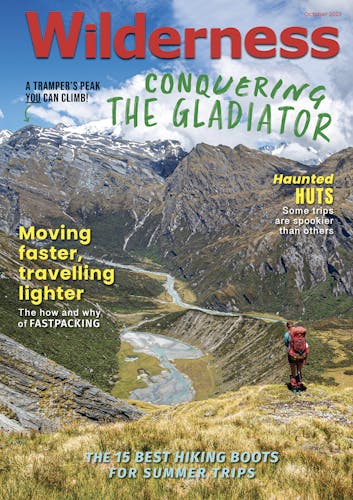Buying gear can be confusing, expensive and non-refundable, so it pays to be aware of common pitfalls.
I’m a gear junkie and have learned about outdoor gear the hard way. In the quest to reach tramping nirvana – where every piece of gear works harmoniously – I’ve bought, sold and borrowed my way through many variations of products.
I’ve made many mistakes along the way and now hope readers can learn from them.
The best fit
I’d bet my paycheck that boots are the toughest tramping essentials to get right, and I’m sure we all have stories of the pair that fitted perfectly in store, only to bite chunks off our heels 10 minutes into an incline. Boots are not an easy purchase, and they’re expensive, which is why I can’t stress enough the importance of a professional boot fitting. Frankly, if staff are giving you boots to try on without first measuring your feet, take your feet somewhere else. An experienced staff member will know which brands and models will (or won’t) fit before you’ve tried them on. Heat-moulded custom insoles can also be made for you, which is every bit as good as it sounds.

Broaden your search
Just as catering prices skyrocket the moment the word ‘wedding’ is used, gear deemed ‘outdoor’ or ‘hiking-specific’ can also be inflated. Sure, we have outdoor brands we love and trust, and local gear shops we go out of our way to support, but don’t fall into the trap of only purchasing outdoor brands. Sometimes a mug is just a mug, a hat is just a hat, and there’s no need to seek out everyday items from specialised shops when they are cheaper at your local supermarket or op shop.
Understand temperature ratings
It amazes me that the great minds of insulation developed something as idiotic as the International Standard ISO 23537 for sleeping bag temperature ratings. The ‘comfort’ rating is apparently the temperature at which a woman wearing one base layer can have a comfortable sleep, while the ‘transition limit’ tells us the lowest temperature a man – also wearing a base layer – can sleep without shivering, whilst curled up in a ball for warmth.
The ‘extreme’ limit is the temperature you will hopefully survive, though no promises for your extremities – you’ll likely lose those to frostbite. Confused? Me too. In a few sentences we’ve changed sleeping positions, swapped genders and possibly lost a few toes. The average buyer should ignore everything but the ‘comfort’ rating. Consider it the lowest temperature in which you would use your bag, and you’ll sleep just fine.

Beware ‘water resistant’ products
Do you know what’s water resistant? Newspaper. Not for long, but, hopefully, you get my point. Run from the car to your front door under a folded newspaper and you’ll remain dry, but run around the block and it will soak through. During my time working in outdoor retail, I discovered few customers knew the difference between waterproof and water-resistant.
So what is the difference? Water-resistant gear will repel water for a time (perhaps five minutes, perhaps an hour), while waterproof gear should be impermeable to water. Gear junkies will no doubt count waterhead or hydrostatic head, but for the casual buyer, it’s as simple as reading the label or asking at the shop: waterproof or water resistant?
Supersize me
As the mantra goes, tramping comfortably is all about layers, and while it may seem obvious, those outer layers need to fit over the base and mid-layers. There may even be times when your rain jacket has to fit over four or five layers of bulky clothes – I know, I’ve been there. Manufacturers know this when designing outer layers like raincoats, making them large enough to allow for layering underneath. I like to layer up in store before choosing my final size, just to make sure it’s not a squeeze.
Buy for your typical trip
It’s human nature to want the best, but experience has taught me the ‘best’ gear isn’t always the most expensive or well-reviewed product but the one that’s best-suited to your typical tramping trip.
My first sleeping bag was a quality Macpac bag. It was rated to sub-zero temperatures, but, as an Auckland-based tramper, I soon discovered I owned a sweat-sack unsuited to my North Island hut tramps. I kept it for a few years before swapping it for a cooler bag.
Kiwi trampers are well-conditioned to prepare for the worst, and I believe this preparedness is reflected in buying habits: products are bought for extreme rather than typical conditions. It takes self-awareness and self-restraint to break the habit of upselling ourselves, but a good place to start is an honest evaluation of your tramping style. Are you a summer tramper? Do you stick to bookable huts? If yes, do you really need a sub-zero sleeping bag? Are you a member of LandSAR or a keen hunter? No? Then perhaps you don’t need a headlamp packing 1000+ lumens. I’m not advocating for trampers to go unprepared, only to find a balance of quality and necessity.








